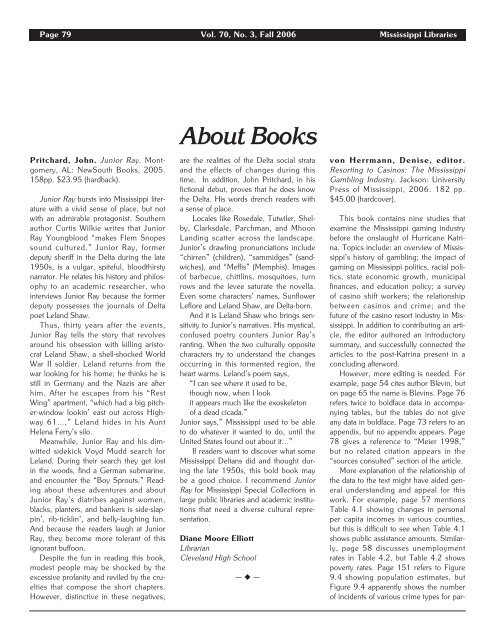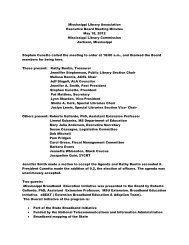Full Text (PDF) - Mississippi Library Association
Full Text (PDF) - Mississippi Library Association
Full Text (PDF) - Mississippi Library Association
You also want an ePaper? Increase the reach of your titles
YUMPU automatically turns print PDFs into web optimized ePapers that Google loves.
Page 79 Vol. 70, No. 3, Fall 2006 <strong>Mississippi</strong> Libraries<br />
Pritchard, John. Junior Ray. Montgomery,<br />
AL: NewSouth Books, 2005.<br />
158pp. $23.95 (hardback).<br />
Junior Ray bursts into <strong>Mississippi</strong> literature<br />
with a vivid sense of place, but not<br />
with an admirable protagonist. Southern<br />
author Curtis Wilkie writes that Junior<br />
Ray Youngblood “makes Flem Snopes<br />
sound cultured.” Junior Ray, former<br />
deputy sheriff in the Delta during the late<br />
1950s, is a vulgar, spiteful, bloodthirsty<br />
narrator. He relates his history and philosophy<br />
to an academic researcher, who<br />
interviews Junior Ray because the former<br />
deputy possesses the journals of Delta<br />
poet Leland Shaw.<br />
Thus, thirty years after the events,<br />
Junior Ray tells the story that revolves<br />
around his obsession with killing aristocrat<br />
Leland Shaw, a shell-shocked World<br />
War II soldier. Leland returns from the<br />
war looking for his home; he thinks he is<br />
still in Germany and the Nazis are after<br />
him. After he escapes from his “Rest<br />
Wing” apartment, “which had a big pitcher-window<br />
lookin’ east out across Highway<br />
61…,” Leland hides in his Aunt<br />
Helena Ferry’s silo.<br />
Meanwhile, Junior Ray and his dimwitted<br />
sidekick Voyd Mudd search for<br />
Leland. During their search they get lost<br />
in the woods, find a German submarine,<br />
and encounter the “Boy Sprouts.” Reading<br />
about these adventures and about<br />
Junior Ray’s diatribes against women,<br />
blacks, planters, and bankers is side-slappin’,<br />
rib-ticklin’, and belly-laughing fun.<br />
And because the readers laugh at Junior<br />
Ray, they become more tolerant of this<br />
ignorant buffoon.<br />
Despite the fun in reading this book,<br />
modest people may be shocked by the<br />
excessive profanity and reviled by the cruelties<br />
that compose the short chapters.<br />
However, distinctive in these negatives,<br />
About Books<br />
are the realities of the Delta social strata<br />
and the effects of changes during this<br />
time. In addition, John Pritchard, in his<br />
fictional debut, proves that he does know<br />
the Delta. His words drench readers with<br />
a sense of place.<br />
Locales like Rosedale, Tutwiler, Shelby,<br />
Clarksdale, Parchman, and Mhoon<br />
Landing scatter across the landscape.<br />
Junior’s drawling pronunciations include<br />
“chirren” (children), “sammidges” (sandwiches),<br />
and “Meffis” (Memphis). Images<br />
of barbecue, chittlins, mosquitoes, turn<br />
rows and the levee saturate the novella.<br />
Even some characters’ names, Sunflower<br />
Leflore and Leland Shaw, are Delta-born.<br />
And it is Leland Shaw who brings sensitivity<br />
to Junior’s narratives. His mystical,<br />
confused poetry counters Junior Ray’s<br />
ranting. When the two culturally opposite<br />
characters try to understand the changes<br />
occurring in this tormented region, the<br />
heart warms. Leland’s poem says,<br />
“I can see where it used to be,<br />
though now, when I look<br />
it appears much like the exoskeleton<br />
of a dead cicada.”<br />
Junior says,” <strong>Mississippi</strong> used to be able<br />
to do whatever it wanted to do, until the<br />
United States found out about it…”<br />
If readers want to discover what some<br />
<strong>Mississippi</strong> Deltans did and thought during<br />
the late 1950s, this bold book may<br />
be a good choice. I recommend Junior<br />
Ray for <strong>Mississippi</strong> Special Collections in<br />
large public libraries and academic institutions<br />
that need a diverse cultural representation.<br />
Diane Moore Elliott<br />
Librarian<br />
Cleveland High School<br />
— ◆ —<br />
von Herrmann, Denise, editor.<br />
Resorting to Casinos: The <strong>Mississippi</strong><br />
Gambling Industry. Jackson: University<br />
Press of <strong>Mississippi</strong>, 2006. 182 pp.<br />
$45.00 (hardcover).<br />
This book contains nine studies that<br />
examine the <strong>Mississippi</strong> gaming industry<br />
before the onslaught of Hurricane Katrina.<br />
Topics include: an overview of <strong>Mississippi</strong>’s<br />
history of gambling; the impact of<br />
gaming on <strong>Mississippi</strong> politics, racial politics,<br />
state economic growth, municipal<br />
finances, and education policy; a survey<br />
of casino shift workers; the relationship<br />
between casinos and crime; and the<br />
future of the casino resort industry in <strong>Mississippi</strong>.<br />
In addition to contributing an article,<br />
the editor authored an introductory<br />
summary, and successfully connected the<br />
articles to the post-Katrina present in a<br />
concluding afterword.<br />
However, more editing is needed. For<br />
example, page 54 cites author Blevin, but<br />
on page 65 the name is Blevins. Page 76<br />
refers twice to boldface data in accompanying<br />
tables, but the tables do not give<br />
any data in boldface. Page 73 refers to an<br />
appendix, but no appendix appears. Page<br />
78 gives a reference to “Meier 1998,”<br />
but no related citation appears in the<br />
“sources consulted” section of the article.<br />
More explanation of the relationship of<br />
the data to the text might have aided general<br />
understanding and appeal for this<br />
work. For example, page 57 mentions<br />
Table 4.1 showing changes in personal<br />
per capita incomes in various counties,<br />
but this is difficult to see when Table 4.1<br />
shows public assistance amounts. Similarly,<br />
page 58 discusses unemployment<br />
rates in Table 4.2, but Table 4.2 shows<br />
poverty rates. Page 151 refers to Figure<br />
9.4 showing population estimates, but<br />
Figure 9.4 apparently shows the number<br />
of incidents of various crime types for par-














